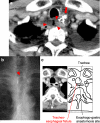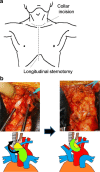Successful repair using thymus pedicle flap for tracheoesophageal fistula: a case report
- PMID: 29796790
- PMCID: PMC5966367
- DOI: 10.1186/s40792-018-0458-8
Successful repair using thymus pedicle flap for tracheoesophageal fistula: a case report
Abstract
Background: Treatment for tracheoesophageal fistula (TEF), a life-threatening complication after esophagectomy, is challenging.
Case presentation: A 75-year-old man with thoracic esophageal cancer underwent subtotal esophagectomy and gastric tube reconstruction through the post-mediastinal root after neoadjuvant chemotherapy. Owing to postoperative anastomotic leakage, an abscess formed at the anastomotic region. Sustained inflammation from the abscess caused refractory TEF between the esophagogastric anastomotic site and membrane of the trachea, and several conservative therapies for TEF failed. Hence, the patient underwent surgery including division of the fistula, direct suturing of the leakage sites, and reinforcement with the flap of the thymus pedicle. As a result, the abscess and TEF disappeared after surgery and the patient was immediately administered an oral diet and discharged home 103 days after initial surgery.
Conclusions: Although pedicle flaps for the reinforcement of TEF are usually obtained from muscle or pericardium, these flaps need enough lengths to overcome moving distance. We are the first in the existing literature to have successfully treated TEF with surgical repair using a thymus flap located close to TEF. The thymus pedicle might be another candidate for the reinforcement flap in TEF.
Keywords: Esophageal cancer; Post-operative complication; Thymus pedicle flap; Tracheoesophageal fistula.
Conflict of interest statement
Ethics approval and consent to participate
Written informed consent was obtained from the patient for publication of this case report and its accompanying images. A copy of the written consent is available for review by the editor-in-chief of this journal on request.
Competing interests
The authors declare that they have no competing interests.
Publisher’s Note
Springer Nature remains neutral with regard to jurisdictional claims in published maps and institutional affiliations.
Figures




Similar articles
-
Development of fistula between esophagogastric anastomotic site and cartilage portion of trachea after subtotal esophagectomy for cervical esophageal cancer: a case report.Surg Case Rep. 2016 Dec;2(1):107. doi: 10.1186/s40792-016-0238-2. Epub 2016 Oct 6. Surg Case Rep. 2016. PMID: 27714646 Free PMC article.
-
Post-esophageal atresia repair double acquired tracheoesophageal fistulas treated successfully by gastric transposition: a case report.Surg Case Rep. 2020 Sep 25;6(1):224. doi: 10.1186/s40792-020-01004-7. Surg Case Rep. 2020. PMID: 32975613 Free PMC article.
-
Tracheoesophageal fistula after total resection of gastric conduit for gastro-aortic fistula due to gastric ulcer.Surg Case Rep. 2017 Aug 23;3(1):90. doi: 10.1186/s40792-017-0371-6. Surg Case Rep. 2017. PMID: 28831760 Free PMC article.
-
Tracheoesophageal fistula.Chest Surg Clin N Am. 2003 May;13(2):271-89. doi: 10.1016/s1052-3359(03)00030-9. Chest Surg Clin N Am. 2003. PMID: 12755313 Review.
-
Surgery for intrathoracic tracheoesophageal and bronchoesophageal fistula.Ann Transl Med. 2018 Jun;6(11):210. doi: 10.21037/atm.2018.05.25. Ann Transl Med. 2018. PMID: 30023373 Free PMC article. Review.
Cited by
-
[Surgical treatment of esophagotracheal and esophagobronchial fistulas].Chirurg. 2019 Sep;90(9):722-730. doi: 10.1007/s00104-019-1006-1. Chirurg. 2019. PMID: 31384993 Review. German.
-
Gastro-tracheal fistula following esophageal cancer surgery through the retrosternal route: a case report.Surg Case Rep. 2024 Nov 4;10(1):252. doi: 10.1186/s40792-024-02052-z. Surg Case Rep. 2024. PMID: 39489816 Free PMC article.
-
Anesthesia management for tracheoesophageal fistula closed with a new gastrointestinal occluder device: a case report.J Cardiothorac Surg. 2022 Nov 16;17(1):287. doi: 10.1186/s13019-022-02038-8. J Cardiothorac Surg. 2022. PMID: 36384539 Free PMC article.
-
Intraoperative methods for wrapping anastomoses after airway reconstruction: a case series.Transl Lung Cancer Res. 2022 Jun;11(6):1145-1153. doi: 10.21037/tlcr-22-406. Transl Lung Cancer Res. 2022. PMID: 35832451 Free PMC article.
-
Airway and anesthesia management in tracheoesophageal fistula closure implantation: a single-centre retrospective study.J Cardiothorac Surg. 2024 Apr 3;19(1):172. doi: 10.1186/s13019-024-02737-4. J Cardiothorac Surg. 2024. PMID: 38570837 Free PMC article.
References
LinkOut - more resources
Full Text Sources
Other Literature Sources
Research Materials

